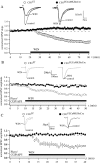Cannabinoid receptor type 1 located on presynaptic terminals of principal neurons in the forebrain controls glutamatergic synaptic transmission
- PMID: 16723537
- PMCID: PMC6675276
- DOI: 10.1523/JNEUROSCI.0372-06.2006
Cannabinoid receptor type 1 located on presynaptic terminals of principal neurons in the forebrain controls glutamatergic synaptic transmission
Erratum in
- J Neurosci. 2006 Jun 14;26(24):table of contents
Abstract
It is widely accepted that cannabinoids regulate GABA release by activation of cannabinoid receptor type 1 (CB1). Results obtained from a variety of brain regions consistently indicate that cannabinoid agonists can also reduce glutamatergic synaptic transmission. However, there are still conflicting data concerning the role of CB1 in cannabinoid-induced inhibition of glutamatergic transmission in cortical areas. Here, we provide direct evidence that activation of CB1 on terminals of principal neurons controls excitatory synaptic responses in the forebrain. In slices of the basolateral amygdala, the CA1 region of the hippocampus, and the primary somatosensory cortex of wild-type mice, application of the CB1 agonist (R)-(+)-[2,3-dihydro-5-methyl-3-(4-morpholinylmethyl)pyrrolo[1,2,3-de]-1,4-benzoxazin-6-yl]-1-naphthalenylmethanone (WIN55,212-2; WIN) (5 mum) reduced evoked excitatory postsynaptic responses. In contrast, in slices obtained from conditional mouse mutants lacking CB1 in all principal forebrain neurons but not in GABAergic interneurons (CB1(f/f;CaMKIIalphaCre)), WIN no longer affected glutamatergic synaptic transmission in any of the brain regions tested. Compatible with a presynaptic mechanism, WIN did not change the sensitivity to focally uncaged l-glutamate. WIN reduced glutamatergic responses in slices obtained from mice lacking CB1 exclusively in GABAergic neurons (CB1(f/f;Dlx5/6-Cre)), thus excluding the involvement of CB1 expressed on GABAergic neurons in this effect of the drug. The present data strongly indicate that excitatory synaptic transmission in forebrain areas is directly modulated by CB1 expressed on presynaptic axon terminals originating from glutamatergic neurons.
Figures




References
-
- Auclair N, Otani S, Soubrie P, Crepel F (2000). Cannabinoids modulate synaptic strength and plasticity at glutamatergic synapses of rat prefrontal cortex pyramidal neurons. J Neurophysiol 83:3287–3293. - PubMed
-
- Breivogel CS, Walker JM, Huang SM, Roy MB, Childers SR (2004). Cannabinoid signaling in rat cerebellar granule cells: G-protein activation, inhibition of glutamate release and endogenous cannabinoids. Neuropharmacology 47:81–91. - PubMed
-
- Casanova E, Fehsenfeld S, Mantamadiotis T, Lemberger T, Greiner E, Stewart AF, Schutz G (2001). A CamKIIalpha iCre BAC allows brain-specific gene inactivation. Genesis 31:37–42. - PubMed
-
- Dodt H, Eder M, Frick A, Zieglgänsberger W (1999). Precisely localized LTD in the neocortex revealed by infrared-guided laser stimulation. Science 286:110–113. - PubMed
Publication types
MeSH terms
Substances
LinkOut - more resources
Full Text Sources
Molecular Biology Databases
Miscellaneous
